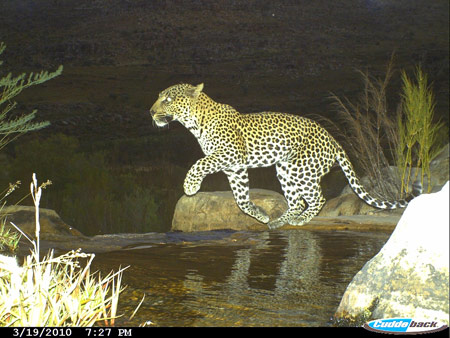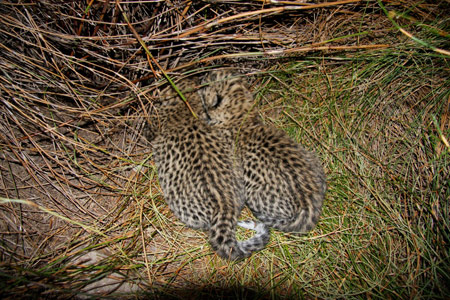Following the discovery of the den, Quinton Martins, project manager of The Cape Leopard Trust was visibly ecstatic, This is an amazing discovery, but man it has taken hard work! Martins is currently concluding a PhD through the University of Bristol, U.K.
To begin with, we had monitored this particular Cederberg female leopard, F10, affectionately known as Spot, for 19 months, regularly analysing her movements via her GPS-radio collar.
By studying the data from her high tech collar, Martins and his team were able to determine Spots feeding habits, home range, movement and activity. Retrospective analyses of GPS tracking data meant they knew that she had mated with a male leopard, M6, known as Max, in late September 2009. Assuming that Spot was pregnant, it was hoped that intensive monitoring of her movements would ultimately lead to the discovery of her den site.

Max, the father of Spots cubs
On the 10th of January, we were unable to secure a GPS download from Spot and we could not locate her there was simply no signal!
Martins, his wife Elizabeth, and assistant Willem Titus immediately went on high alert. We searched day and night but there was simply no sign of her. Having a gut feel that she had given birth, I was desperate to find her. Eventually on the 12th of January I got a faint signal from her collar, which allowed me to get close enough for a download, Martins explains.
Once the data had been analysed, Martins knew that Spot had established a den site and moreover, it appeared that the cubs had been born on the 7th of January, only 5 days prior.
Now the priority for the team was to find the exact location of the den and to establish if indeed there were any cubs. This required a careful strategy - to avoid getting in the way of Spot or frightening her away from the den site.
GPS data showed Spot kept returning to a specific area I suspected was the den site. I used the GPS radio collar to guide us in knowing when Spot moved from the den on a foray far from the area, thus ensuring no contact with her while searching for the cubs. The terrain was extremely rough. When Spot was away, I took the opportunity to climb down to see if I could locate the site.
After an intensive 20-minute search on his hands and knees, Martins eventually found the den in a nest of restios behind some large boulders.
I could hardly believe it there, lying cuddled together in a grassy nest, lay two tiny leopard cubs. Their eyes where still closed and they seemed so small and helpless. I took a few quick photos before making a hasty exit back to the others.

One-week old leopard cubs
During the foray, Martins was mindful of the need not to disturb the cubs or the den site unnecessarily. The next step was to record the development of the cubs and interactions with their mother from a safe distance. The monitoring of leopard cubs in the wild has never been documented in the Western Cape before and this, says the Cape Leopard Trust, is of profound importance for the understanding of these enigmatic leopards and consequently their conservation.
Since finding the cubs, Martins and his team monitored their movements closely. For the first few months, Spot moved her cubs regularly, carefully choosing safe sites to hide her cubs while she went off to hunt and maintain her territory.
The sites were well chosen, and it appeared impossible for anything (or anyone) to crawl into the cracks of these rocky outcrops, stated Martins. We were fortunate to be watching from a safe distance as Spot returned to her cubs at their third den site and caught a glimpse of her carrying her crying cub to a shady place to suckle. During this process, screaming from the hungry cubs attracted the attention of two Black Eagles flying overhead. We wondered how frequently these apex aerial predators killed leopard cubs, having seen these birds dive-bomb adult leopards.
As time passed, the team still saw signs of the cubs their tiny spoor in front of their sixth den site. However, after a few months, her denning pattern changed abruptly.
From her regularly moving den sites, she had suddenly ceased to show any signs of having a den, explains Martins. We were no longer certain whether Spots cubs were still alive, as it seemed they would have been too young to follow her around.
However, it wasnt long before the Cape Leopard Trust found a fresh klipspringer kill Spot had made. Along with the kill, they found a couple of Spots scats, and one very small scat, providing a faint glimmer of hope that one of the cubs could still be alive.
It is clearly an extremely tough environment for bringing up leopard cubs in and we already know that the survival rate for leopard cubs in the best environments is low. According to Martins there are various dangers including predators such as black eagles and snakes, sickness and malnutrition.
Surprisingly, one of the greatest dangers is infanticide. As soon as a new dominant male comes into contact with cubs that are not his, he kills them. Naturally, this occurs when a stronger individual ousts a dominant male from his territory. Ideally, the female needs a stable system, where the dominant male keeps other males out, to have a better chance of cub survival.
Last month the Cape Leopard Trust found definite signs that at least one of the cubs was still alive.
Martins recalls the moment, We were looking for Spots tracks on a sandy section of road, when to our astonishment we saw not only Spots spoor, but the tracks of a cub right next to hers.
A week later, they got the irrefutable proof that they were looking for, a photograph of Spot and her cub.

Irrefutable proof that at least one of Spots cubs has survived
Now that they are certain that at least one cub is still alive they are redoubling their efforts to follow Spot and her cubs movements closely and hope to be able to get video footage of Spot with her cub.
Stephen Harris, Professor of Environmental Sciences at the University of Bristol, UK, says, "The Cape Leopard Trust has already done some amazing work, and now they have a fantastic opportunity to document the breeding behaviour of leopards in the Cape mountains. The Trust already has a great deal of expertise using modern technologies, and this discovery has shown the value of remotely monitoring leopards using GPS collars. The results are absolutely fascinating, and great photos to boot!
The Cape Leopard Trust, working closely with the statutory conservation body Cape Nature, has research projects in the Cederberg, Gouritz Corridor, Namaqualand and the Boland mountains.
Adopt a Spot at R500/year and receive exclusive updates on Spot and her cubs activities while supporting the research of the Cape Leopard Trust. For more information visit www.capeleopard.org.za.















